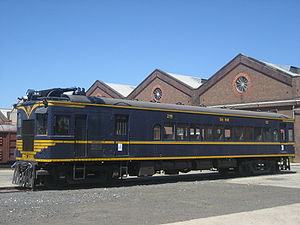Diesel Electric railmotor (VR)

58RM at Newport Workshops
|
|||||||||||||||||||
|
|||||||||||||||||||
|
|||||||||||||||||||
|
|||||||||||||||||||
|
|||||||||||||||||||
| Type and origin | |
|---|---|
| Power type | Diesel engine, Originally Petrol |
| Designer | based off a St. Louis Car Company design |
| Builder | Newport Workshops |
| Build date | 1928 - 1931 |
| Total produced | 10 |
| Specifications | |
|---|---|
| Gauge | 5 ft 3 in (1,600 mm) |
| Length | 58 ft (18 m) |
| Loco weight | 43.07 long tons (43.76 t; 48.24 short tons) |
| Fuel type | Originally Petrol, converted to Diesel fuel |
| Fuel capacity | 750 litres (200 US gal) |
| Engine type | 220 hp Winton six-cylinder petrol engine (Petrol) 2 x Series 71 twin six-cylinder diesel engines (Diesel) |
| Generator | General Electric DT 501E2 |
| Traction motors | 2 x General Electric GE 273A |
| Performance figures | |
|---|---|
| Maximum speed | 100 kilometres per hour (62 mph) |
| Power output | 220 hp (Petrol), 255 bhp (Diesel) |
| Career | |
|---|---|
| Operators | Victorian Railways, VLine |
| Number in class | 10 |
| Numbers | 55RM - 64RM |
| First run | 1928 |
The Diesel Electric Rail Motor (DERM) was a railmotor operated by the Victorian Railways of Australia.
Originally built as a Petrol Electric Rail Motor (PERM), they were the longest-lived railmotor on the Victorian Railways, with the first entering service in 1928 and the last being withdrawn in 1991. The first was built by Newport Workshops to a design of the St. Louis Car Company. It was powered by a 220 hp Winton Motor Carriage Company petrol engine which was used until the 1950s when they were converted to twin Diesel Electric engines giving a total of 255 bhp.
A DERM with a DERM Trailer car ran a regular passenger train on the South Gippsland line in the 1960s - 1970s. By the 1970s the longest regular scheduled journey run by a DERM was the Bendigo to Robinvale run, withdrawn on 3 June 1978.
In 1976 RM 56 was fitted with a new seating arrangement, including rotating seats using components from the Z fleet. Capacity was reduced to 34 passengers, because the new seating arrangement was two either side of the central aisle rather than the previous 2 and 3. The first class end of the vehicle was moved towards the centre; closer to the engine, but providing a smoother ride by averaging the suspension of both bogies rather than just one. The trial arrangement was used on the Yarrawonga line, but patronage did not increase enough to justify the retention of the service.
Following from the changes to 56RM, in the late 1970s 55RM and 61RM were extensively modified with the engines relocated, body extended and a new seating arrangement provided. The most obvious external difference was the fitting of new aluminium-framed windows for the driver cabin, and porthole windows for the engine room. Photo 1 Photo 2 These "Super DERMs" were a familiar sight on the Mornington and Stony Point lines prior to the line closures in the early 1980s.
...
Wikipedia
